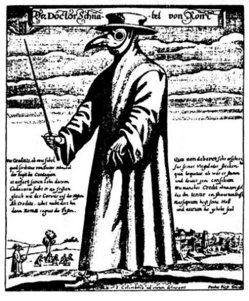Myron Echenberg. Black Death, White Medicine: Bubonic Plague and the Politics of Public Health in Colonial Senegal, 1914-1945. Portsmouth, NH: Heinemann, Oxford: James Currey, and Cape Town: David Philip, 2002. xviii + 303 pp. $28.00 paper.
Relations between Africa and Europe from the First World War through the Second World War, the period covered in Myron Echenberg's stunning account of French colonial medicine and the African response, were determined by the twin exigencies of consolidating (or resisting) European political control and expanding African exports and European imports. The nineteenth century had witnessed the end of the slave trade and European conquest of African kingdoms and chiefdoms. The wars of conquest precipitated famines, disease epidemics and epizootics, and an ecological catastrophe that permanently rearranged the landscape for people, animals and agriculture in parts of the continent. Some of the new afflictions were clearly inadvertent: sandfleas arrived in the ballast of ships returning from Brazil to load new human cargoes on the Congo coast; within twenty years the disease called chiggers spread from the Atlantic to the Indian Ocean, crippling defenseless Africans. But most of the misery Africans experienced in this period was not accidental.
Epidemics are constructed, man-made events. The decision to declare a medical emergency and to grant wide interventionist powers to health officials is political, not medical. Echenberg's study, which shows how the French colonial administration constructed the epidemic of bubonic plague in Senegal, is an important contribution to the growing literature on the social history of African health and disease. Arguably, French authorities were poorly placed to respond to the spreading plague. Unlike the British, which had developed methods to control contagious disease in urban environments during the Sanitary Reform Movement of the 1870s and had established two schools of public health (in Liverpool [1898] and London [1899]), the French had invested little in public health and had no school to train public health practitioners (their strength was in laboratory research). As Echenberg notes, the Dakar Health Committee was composed of clinicians trained in tropical medicine and commissioned by the military. The Ecole Nationale de Sante Publique was created in Rennes in 1947, amid the post-war preoccupation with tuberculosis, the memory of the 1918-1919 flu pandemic, and the creation of WHO. In some sense it would seem that the colonial experience pushed France into public health, whereas the British transferred the metropolitan service model to their colonies.
Residential segregation, based on racial lines, was the main strategy of epidemic control, and land speculators liberally abused it. In Senegal, the French dispossessed the indigenous African population, removing the Dakarois to distant locations and burning their houses. Quarantines, enforced by the army, ensured that Africans did not return to reoccupy the vacated areas of the city. Doctors selectively inoculated Africans, using the Haffkine vaccine, which was of doubtful efficacy and "dangerously potent and even toxic" by today's standards (p. 103). Through medical mismanagement and the primacy of political goals, plague became endemic in Senegal till 1945, when the use of DDT finally interrupted the complicated cycle of disease transmission.
What makes Echenberg's book so absorbing is his analysis of the political scene as seen through the eyes of African actors as well as European officials. Plague erupted against the background of Senegalese demands for political representation (in 1914 Blaise Diagne became the first African elected to the French National Assembly) and French fears of impending war in Europe (by November 1915, 34,000 Senegalese were serving in the French armed forces).
For Africans, the bubonic plague ordeal of 1914 was a political and not a medical event. Sanitary controls, far from being humanitarian in inspiration, were to Africans an elaborate smoke screen motivated by a desire, first, to disallow Blaise Diagne's electoral victory, and, second, to camouflage the grabbing of Lebu property and to remove Africans from the Plateau... Sanitary controls affected traditional practices such as visits to the sick, attendance at funerals, burial practices, and possibly also traditional medical therapy. These controls deprived the community of valuable weapons used by people everywhere to ease social tensions at times of traumatic illness, death, and mourning. (p. 128)
The book is divided into an introduction and three chronological sections-the introduction of plague in 1914, the interwar period, and the years of World War Two. In this last period, plague was finally eliminated with the help of an American medical (and military) presence and the introduction of DDT to kill the fleas that carried plague from rats to humans. The French colonial authorities were initially dismissive of American approaches to public health (with reason in the case of the failed experiment with Antu, a rodenticide that was lethal to dogs, cats and children, but not rats); they delayed the application of new techniques, and they continued with their authoritarian and coercive plans, this time linking plague control to wartime austerity. The results of DDT spraying were dramatic, but the use of the new pesticide did not prevent the ultimate epidemic in 1944, which had a case fatality rate of go percent.
MEREDETH TURSHEN, PH.D., is Professor, E. J. Bloustein School of Planning and Public Policy, Rutgers University, New Brunswick, New Jersey 08903.
Copyright Journal of Public Health Policy 2003
Provided by ProQuest Information and Learning Company. All rights Reserved


